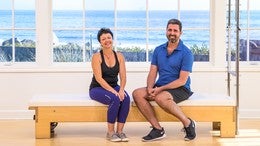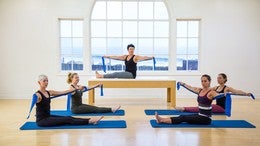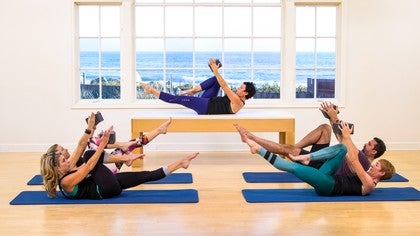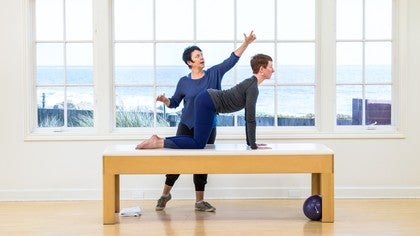Description
About This Video
Transcript
Read Full Transcript
Hi everybody. I'm Kara Reeser and I'm here with, you know, who Amy havens. And um, this is a tutorial. Um, there will be a mat class attached to this tutorial tutorial, um, that you can practice. That's how we're kind of doing that, uh, that matching these days. Um, but this tutorial is, it's sort of exciting to me cause it came to me out of a question that one of my staff members asked, um, in, in the pro class when morning. So I teach these pro classes weekly and um, I leave it open to the students to say, you know, hey, what are you guys thinking about? Just so we can kind of parse apart things. Right. And it was just great. She said to me, um, Kara, what does it mean when your yoga teacher or your plays teacher tells you to plug your arm back into your socket? She's like, cause I say that a lot, but I'm not really sure what it means. And I was like, oh, that is so great. I've really been wanting to talk about this because, um, even though it's a Q, a lot of us use, right? A lot of people use it.
It's actually anatomically not a correct thing to say. So you could say it, but you actually mean something else. So I thought it might be nice to actually talk about what we mean and maybe we'll start saying what we mean, which might be helpful. And I'm not saying you can't say it, but it's really good for us to all know like functionally what, what does that mean? We're saying plug your arm into the socket, right? So let's just start with a little bit of anatomical review. So Amy, um, and I are going to look at, we're going to show you some movements.
We're going to do some protocols that kind of help with, um, basically what I'm going to call today, like gps seeing your scapula. Basically. How are you gonna how do you know where your scaffold is on your rib cage? Um, during so many different movements of spinal articulation, if particularly when you have some force, right? Something's pulling on your hands, right? So the first thing I want to say, Amy, sit with your left arm out for a second.
So most of the time when somebody's saying plug your arm back into your socket, it's because they've seen this, right? And they don't like that look, right? So they're like, plug it in. All right? Really? But what they really mean is to bring the scapula back to a more, what I'm going to call neutral position on the back of the rib cage, right? Her shoulder joint, which is her humorous where it comes into the Scapula at the glenoid Fossa. That actually you don't plug or unplug that joint.
That tune is super secure. I mean, it's, matter of fact, if you did unplug it, we'd be like on our way to the hospital here in Carpentaria, it's probably not one. But you know what I mean? Um, so, so what we're, what we're really trying to say when we say that is to manage the position of the Scapula, the posterior rib cage. Well that sounds like Super Cara stuffy, but a control where your Scapula, how your scaffold is behaving. Okay. So behave scapula. Right? And that doesn't always mean that we want to, oh, sorry baby. That doesn't mean we always want to like create a bunch of tension either, right? So something, it's about really knowing we've got to have a little bit more awareness and then we have to know how to manage force. Okay. So let's just be reminded, first of all, what goes on here and a joint wise in the shoulder complex, right? So you have three major real anatomical joints in your shoulder complex.
You have the sternoclavicular joint, right? Which attaches the entire shoulder girdle to your trunk. So it's relevant. You have the AC joint, right? The a chromium acromion, click color. I always say that wrong. Acromioclavicular joint. And then you have the, the joint of the shoulder, the shoulder joint, which is where the arm goes into the Glenoid Fossa, right? Those are, but we, those are our true anatomical joints. But it's also very useful for the purpose of what we do as movers to think of the, the Scapula, right on the rib cage also as a joint.
Right? And so the way I've heard it talked about, um, is it's a non anatomical joint because it's not like it doesn't have sort of a, a bone on bone contact in the way that a regular joint does or, or like, you know, like a socket, but it still behaves a little bit like a ball and socket, right? So it's like your scapula travels around the surface of your rib cage in a lot of directions. So what we're going to be trying to figure out today is when we're doing mostly pilates, like either Matt or not really so much arms standing, but like when things are, when we're trying to articulate our spines, how do we control some of this excessive movement, um, of the scapula. Right? And one thing is like, why do people do that? Well, you know, if I'm trying to roll up and it's super duper hard, it's a little bit helpful for me to throw a bunch of my weight forward like that. Right? So they're trying to assist themselves, but we want to actually get them moving through their trunks. And so we want to actually, we also have to train them how to manage the slippery slope of the Scapula. Alright. Basically I want to take you through, we're going to go through a couple of, um, maybe useful tips that you could use in your teaching for helping people manage their Scapula, um, while they're trying to move their spines. Right.
So, um, I think the first thing is that it's really helpful for people to know that they have a scapula. Yeah, you could, yeah. Stand up and turn around. So it's really important to your clients. You know, they have a scapula or they know the word shoulder blade, right? But it's very hard to Lo know where your scapula is at any given moment. You know, it's not a really easy thing to feel like, I know where my foot is right now, but like if you asked me when, where it's capitalist, I'd be like, what? Right. So I always like to just make sure, I'm not going to do like a big m topical tracing like we sometimes do, but I'm going to just show Amy, I'm going to say, look, here's the medial light, here's the medial border of your Scapula, here's your spine, here's this, right? And it's a triangle and it goes, it goes like this, and I'm just going to show her, it has a top, it has a side, it has a point, it has a side, right?
So by touching Amy, she's getting a little bit of of information, right? Neurological in feedback so that she's going to be able to start to know when this gets pulled away without permission. Right? So I think it's really useful to use touch you. Clients love touch anyways. So that's always gonna help, right? So standing with their back to you. I can also say that it's really helpful really quickly just to tell your clients how the Scapula move, right? So you don't have to use fancy words. You can say, Hey, I want you to know that your two scapula can move together towards the spine.
Right? And they can move away, right? So they can, I sometimes called this closing the elevator doors or opening the elevators. And you want to know that your client knows how to do that, right? Cause maybe they only know how to do this. So that's why that always happens, right? So we're going to get these motions available. Get the gps of the scapula going on inside the motor neurological self. I'm going to hold her hair up again. Okay.
So now she's going to elevate her scapula, right? So we're going to go up and down. That's another way this capital can move. It can go up and down, right? Right. So we're not going to talk about every movement cause it gets a little tricky, but we're gonna talk about these basic ones, right? So that's up and down. And then there's also the movement when the arms go forward of upward rotation, right? And that's when the scapulas separates and moves up towards the hand.
And then when her arms come back, downward rotation. So the Scapula come together. So there's awkward rotation, right? Our scapulas separate. And then there's ways our arms go back, our scapula together. So let's just watch that one more time. Swings up, right? And it comes together, right?
So that's a natural movement and it's important that clients understand that it's there. Now what gets tricky though, when you're doing [inaudible] is sometimes like, like something like shoulder bridge. So just lie down on your back for a second, Amy. And let's just, let's just all remember this. This is a little pet peeve of mine. So if you're somebody who works with me out there, you've heard this before, but if it, right now, Amy's arms are laying next to her body, right? So she's in a neutral arm position, right? So her scapular would be relatively neutral, meaning where you'd be when you're standing.
But if she goes into a shoulder bridge, what position are our arms in relative to her trunk? Now? Well, G is right here. She can say they're behind, right? So actually the motion of this means the Scapula's gathering together. So every time my person's trunk changes, I want to remind them that their scapula needs to behave along with that change, right? So it can be really helpful. Not to mention when you're up in something like shoulder ridge or roll over, which I will also look at, you're in a much better neck and thoracic spine health if you haven't, if you do this with your shoulder blades, right, then your skin, your spine is really pressing back. So a lot of times you'll see this as a compensatory pattern to coming up into a bridge, right? So you'll see somebody coming up in a bridge and you'll see that, right? She doesn't need to plug her arm in the socket, she needs to manage her scapula on her chest wall.
And it's the same as she was doing something like rollover. This is where you really see it, you guys, right? Everybody comes over and roll over and you see that Scapula protract, right? So I don't want to tell Amy to push her hands down cause she could push your hands down to the cows, come home and she could still protract your shoulder blade, right? I mean, it's a fine cuber hands to be down, but what's going to control her scapula is her arms are about to go behind her. She needs to draw those medial borders. And she knows it's hard.
Let me do it with you. I'll help your legs come up, draw them medial borders of your scapula together. Right? And you see that solves that inward rotation right away, right? There's no more Q that needs to be said except for she needs to know how to locate brain to body communication where her scapula are. So that means during a practice that needs to be brought to her awareness, or maybe we need some pre exercises or some little tricks in our bag to get that scapular awareness, um, in the forefront of, of our moving practice. So, um, I'm going to teach a couple of things that I think might help with that. Some of them come from Cathy Grant, some of them come from wherever.
And then we'll look at a couple PR plottings protocols. Let's just make, get a couple of examples of what we see when somebody sort of has lost control of their scapula. So actually, here's a great example. Go ahead and straighten this knee down on the mat. Bring this knee into your chest. Good. Hold onto your Shin, right? We say this to people all the time, roll up to seated, but go ahead and let that leg really protractors caplet right? So she's gonna Roll Up, right?
And right away what we saw there is that she really pulled this forward, right? So if she has both of her legs out and she's going to do something like roll up and I'm going to help her out with this, right? A lot of times what we see is the Scapula will get pulled way far forward, right? And then we'll say, plug your arm to the soccer. But what we really mean is keep that scapula more neutral on the chest wall as you're articulating your spine, right? So we see that a lot during flection articulation, but we also see that in rotation.
So just spin around for a second, Amy. So a lot of times, like for instance, on stomach massage on the machine, right? So go ahead and put your arms out. What you see that person do is they'll, they'll try to rotate VCV right? Bringing that Scapula into the spine, which actually through our, to our ability to rotate. So again, we're going to gps at Scapula into neutral, and then she's going to start to learn how to actually rotate her spine, right? And that all you also see that presentation on side bending where let's say the person, exactly, they'll actually pull their blade down to create the side bending as opposed to letting the spine leads. So at some level, what we're talking about here is in these moments where we're really teaching spinal articulation, let the scapula gently stay positioned and sort of floaty on the rib cage, right? So it doesn't have to be pulled down. There's going to be fixed. Um, under Bernard, it was a great movement teacher that I studied with at NYU. He used to refer to them as little rowboats and he'd say, it's like they're parked on the, on the bay, you know, like the boat and they're just so no matter what you're doing, they're just sort of floating. Right? But they're, they're not getting pulled all the way into, into the bay or whatever. Okay. So then the question becomes like, how much force do you need? Right? So let's, let's look at roll down right away and just figure out what that is.
So with the roll-down Bar, I'm just gonna move, um, Mr bones over here, um, get 'em out of our way. So when Amy's holding the roll down bar and she's got her feet maybe against the bar, maybe she's doing classical position, I don't know. And our arms are straight. Let's say her knees are straight, just for the, you know, the, right, she starts. So right now, this is where her scapula is resting on her rib cage, right? So I want that to be sort of where it would be if her arms were in front of her. Right. They don't need to be here. And then as she rolls back, right, this bar is starting to pull on her hands.
So if she didn't do anything with her Scapula, her scapular would super get pulled forward. Right? But she doesn't need to cram her scapula down her back cause that's going to put her into extension. She needs to basically figure out how much forces needed as she rolls down to manage that position. And then low and behold when she's down, right, you're going to see her not in this compromised position that then you have to fix once she's laying down. And once she's here, then she's in a great position to do any of the arm protocols that come with this. Right? And then it's the same when she comes up. So she lifts her head, right? She's going to want to lead with that scapular pulling forward. So she's going to have to do a little something. This spring up here is pulling on the medial border of her scapula.
It's not pulling on her shoulder socket. So this is where she has to put her brain and then she's going to roll up trying to manage that. And low and behold she's going to get a lot more movement in her trunk. Okay. So, um, let's just go, let go of that and I think that you guys are going to be able to figure the kind of side bending and rotation stuff out also. So I think that last thing I want to say, um, is just going over that, that position of when your arms are uh, behind you.
Just one more time. Um, so come on back down to or bring your arms behind you like this and let's just see, um, let it come down a little bit this way so we can maybe see your upper back. Right? So what we want is this, Amy comes into a table, right? She's going to really bring that scapula around and hold it together on her back, right? That's what's going to control this shoulder from rolling forward. If she lets her scapula go, go ahead and let it go a little bit, right?
You've seen that before, right? That's, that has to do again with her scapular retractors, right? Come on down. So that's going to come up for you guys in something like long backstretch, shoulder bridge, rollover, jackknife. You know, there's a ton of exercises where the avoidance of this right comes from the control of that. And depending on the demand, the force, the external forces coming into your body, you're gonna have to use more muscle, more and less. And that's, I think really what Polonius is all about is, is modulating. That's what's so exciting about it. Like, Oh yeah, I gotta tune this up, tune this down, bring this in, bring this out, you know, that kind of thing. Um, I would say my favorite goto shoulder blade blade training, exercise, pre exercise, or I'm going to say I have two or three of them. One of them is just teaching shoulder shrugs. Now, I usually teach this prone, but I want you guys to be able to see Amy's too. She's gonna put her legs this way. So let, basically what I'm saying now is, let's say you have somebody and they don't have, they don't know how to do this.
We need to train them to move their scapula around. So she's going to hold her arms up in this kind of, um, goalpost position. And I'm going to ask her, I'm going to teach her to learn how to move this gap scapula in elevator doors, right? So she's going to go up or scapulas squeezes together. Great. And then it comes apart great. You see how she's not moving her arm? She's super good at this, right? We've done this together. So, right. Most people are going to try to find that by moving their arm. Right?
So we're trying to get her to find them. We'll go mid Scapula to gather a little harder for a mid and apart mid scapula together. Great. There it is a part low scapula. Now with the low Scapula, the arms will probably come down a little bit and apart. Right? So I would say if you're not teaching people those, the, those changes of the Scapula, it's really hard to ask them to control their scapula with forest. Right? Cause they have to know what does that right.
So I love teaching shoulder shrugs, and then Kathy always taught us we're gonna lie supine here. Um, she always taught us the same thing with the, with the push shoe bar. Um, and we do a whole series of this in the, in the heritage training, but just this alone can be, again, another really helpful person for basically your client had gps, their scapula better. So you can just hold the straight arm bar right onto the shoulder, loaded with the spring, and then the skeptical comes apart. It's the same movement and the scapula comes together and just have your client play with this a little bit so that they know where that is. Right. And you can even describe to them, Hey, when you get to that place where your arms would be if they were down by your side, that's your kind of neutral, right?
That's where you want to be when you're doing roll up. When you're doing things like spine stretch forward, right? You don't want to have this reaching forward. And then they could practice bending their elbows, right. And seeing if they can maintain that. And then of course as she goes up, she's going into that upward rotation and then back through. That's great.
Right? So as it feels really good, this, this movement is like a, it's like a miracle massage, you know, because we get so stuck, um, fixating our shoulder girdle, you know, and this is more about modulating, you know, modulating or, or, um, calibrating the movement. Go ahead and let go. Great. So when Amy does a roll up, she has a little spot in her back that does not want to give it up, right? So we're going to let, I'm gonna keep her knees bent and I'm just gonna ask Amy to gps her Scapula, right? So not pulling them down, not just letting them stay where they would be and she's gonna lift her head, neck, and shoulders, and she's gonna Pause and she's gonna notice her tendency to wanna. You feel how your body is going to want to help you there.
So you're going to keep your scapula where they are. You're going to come up a little more pause. Good. And they keep coming through that learning how not to pull through without scapula. Right? And she actually just really did that, right? So if she was doing something like spine stretch forward, right, we'd want the same thing from her. We want her head to go forward, we'd want her spine to go, but we wouldn't want her to express his exercise by pulling there. So you can actually just apply this scapula gps to every move you do and your daily Volandes practice. Right. So again, you know, you guys are the pros, you have plenty of strategies, but I just thought it was just such a great conversation because I think, you know, even when I go to yoga class and they say, plug my arm into the socket, I get a visual in my head.
That's actually a little conflicted with the movement I'm actually being asked to do. So I think it was just really helpful when when my student asked me that and I could say, Oh yeah, let's clear that up. So I wanted to bring it over and offer it. Um, we're going to do a math class now where we're just going to be gps saying the Scapula the whole time, just super scapula awareness, a workout. Um, and so I hope you'll join us there. Thanks baby.
The Teacher's Corner: Neck and Shoulder Awareness
Comments
You need to be a subscriber to post a comment.
Please Log In or Create an Account to start your free trial.
































